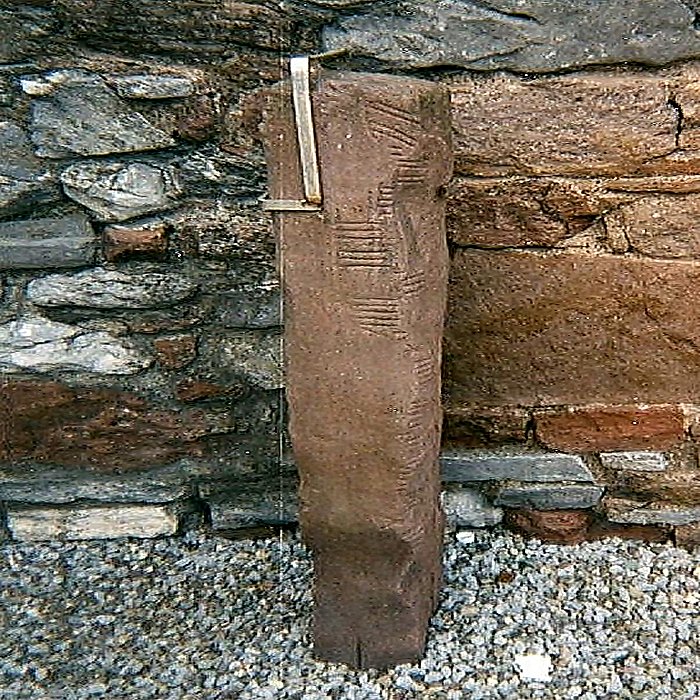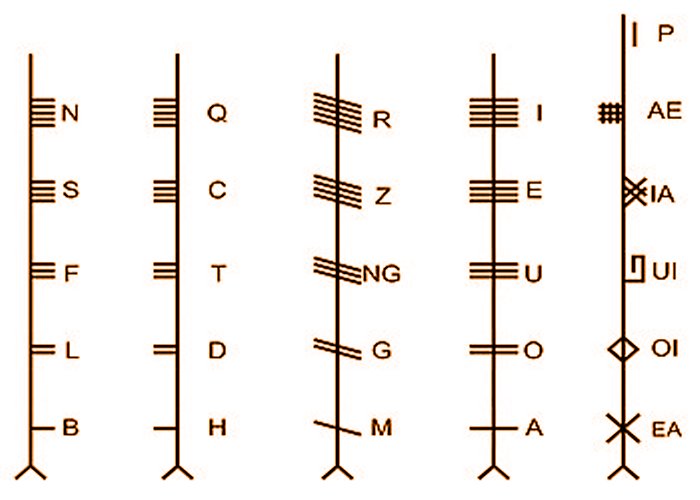Ogham: Unique Celtic Alphabet Used By Druids And Abandoned During Christian Era
A. Sutherland - AncientPages.com - Ogham is ancient writing, of which the earliest examples date back to the 4th and 6th centuries A.D. The language of the inscriptions is Irish, but many inscriptions were found to have other equivalents in Roman and Latin; inscriptions in Scotland used the Ogham script with Old Norse or Pictish.
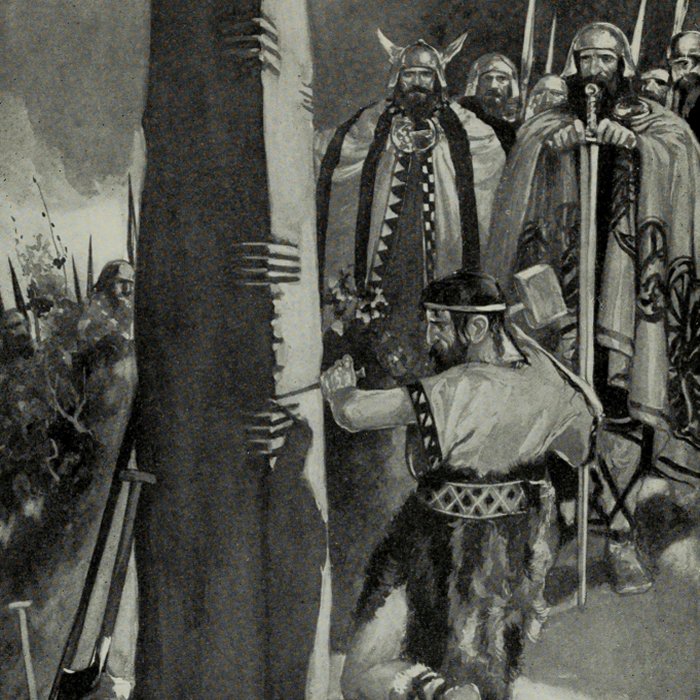 Carving of Ogham letters into a stone pillar - illustration by Stephen Reid (1873 - 1948), in: Myths & Legends of the Celtic Race by T. W. Rolleston (1857 - 1920), published 1911, p. 288. source
Carving of Ogham letters into a stone pillar - illustration by Stephen Reid (1873 - 1948), in: Myths & Legends of the Celtic Race by T. W. Rolleston (1857 - 1920), published 1911, p. 288. source
About 360 ogham stones have been recorded in Ireland (in Munster, Kerry, Cork, and Waterford), and the total number is more than 400, including those found in Britain. The ogham stones found in Scotland, Wales, and the Isle of Man are all linked to the Irish settlements that existed during the decline of the Roman Empire.
Numerous ancient literary sources suggest that the script was used by Celtic druids about two thousand years ago and functioned even in the times of St. Patrick in the 5th century. It was also practiced by bards, intellectuals, and others who knew how to read the Oghams.
Each Ogham letter has five lines, and it is pretty simple. Each line is read from bottom to top; the more content, the higher the stone. It has no tricky grammatical problems.
Ancient writing was preserved not only in stone but was also practiced using wood. Still, wood would not survive long due to weather and the passage of time.
The Oghams were found chiefly on boundary stones and burial markers across Scotland, Wales, Ireland, and England. However, burial markers were not many since it took a great deal of effort to dig a huge hole, find an appropriate boulder, move and place it next to the deceased person and then have a stone cutter properly mark it. It is believed that any ogham burial marker was for a person of some fame or money (or both).
An inscription was found in 1975 in Ratass Church, Tralee, County Kerry. Image credit: Jaqian - CC BY-SA 3.0
Ogham inscriptions were carved starting at the bottom left-hand side of the stone face. The Ogham is usually read upwards along the left-hand edge of the stone, sometimes across the top, and then down to the other side.
It is believed that the letters of Ogham are much older than the inscriptions. They were used for inscriptions on stones and contained a series of twenty characters arranged in four groups; each group formed one to five notches disposed of in one of four patterns: up, down, diagonal, and straight through.
They are carved on the edge of a piece of stone or wood.
Legends, Tales And Unknown Origin Of Ogham
The word 'ogham' is of unclear origin. The Ogham alphabet graphically represented the Pictish and Irish languages on stony monuments, mostly between 400 and 600 BC. When the spread of Christianity in Europe began, the system was considered a pagan legacy, and gradually, people stopped using it. However, the knowledge of the Ogham alphabet is still alive, and its samples attest to its use as late as the 19th century. Today, many people use the ogham as a divination tool, although there are only a few examples from ancient literature.
Ogham (Ogam), dated to 2200 BC, was an alphabet named after the ancient Irish god Ogma. Image credit: Runologist - CC BY-SA 4.0
There are several theories and pure guesses about its origin, but precisely when this mysterious system was introduced is unknown. Some relate the ogham to the runic alphabet, while others believe it is much older. In mythology, ogham was usually used in magic (mainly spells), but ancient Ogham stone inscriptions contained important messages only understood by heroes, magicians, gods, and warlords.
Legend has it the writing comes from the name of the Irish god Ogma, the Celtic god of eloquence and literature, and the invention of it is attributed to him as he was skilled in poetry and speech and created the system for the chosen ones – people who possess the knowledge. Ogma is known from the Irish lore as one of the Túatha Dé Danann.
Damian McManus, Professor of Early Irish at Trinity College, Dublin, and Head of the Department of Irish quotes it in "A Guide to Ogham." It reads as follows: "The inventor here is Ogma mac Elathan who is said to have been skilled in speech and poetry and to have created the system as proof of his intellectual ability and with the intention that it should be the preserve of the learned, to the exclusion of the rustics and fools."
Another legend is related to the Ogham stones with a small hole drilled in them. It says that those wanting to seal a deal or a contract would go to the rock, put fingers through the hole, and state their sides of the bargain, swearing by the bones of their ancestors beneath their feet. In case those who should not keep their part would suffer a curse.
Written by – A. Sutherland - AncientPages.com Senior Staff Writer
Updated on May 18, 2024
Copyright © AncientPages.com All rights reserved. This material may not be published, broadcast, rewritten or redistributed in whole or part without the express written permission of AncientPages.com
Expand for referencesReferences:
Matthews, Caitlin. Celtic Wisdom Sticks
Bailey M. Oghams; Letters inscribed in Stone
O'Sullivan, Muiris, and Liam Downey. "OGHAM STONES." Archaeology Ireland 28, no. 2 (2014): 26-29.
More From Ancient Pages
-
 Rare Iron- And Viking-Age Mortuary Houses Discovered In Norway
Archaeology | Aug 27, 2024
Rare Iron- And Viking-Age Mortuary Houses Discovered In Norway
Archaeology | Aug 27, 2024 -
 Unexplained Disappearance Of East Balkan Civilizations – Discovery Of Unusual Mini Artifacts – Part 1
Ancient Mysteries | Apr 28, 2018
Unexplained Disappearance Of East Balkan Civilizations – Discovery Of Unusual Mini Artifacts – Part 1
Ancient Mysteries | Apr 28, 2018 -
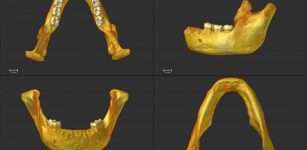 Settlement Of Europe: Result Of Several Migration Waves By A Single Population – Study
Archaeology | Jul 17, 2020
Settlement Of Europe: Result Of Several Migration Waves By A Single Population – Study
Archaeology | Jul 17, 2020 -
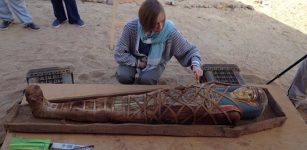 Wooden Coffin With Greco-Roman Mummy Wearing Mask Depicting Sky God Discovered In Egypt
Archaeology | Nov 17, 2017
Wooden Coffin With Greco-Roman Mummy Wearing Mask Depicting Sky God Discovered In Egypt
Archaeology | Nov 17, 2017 -
 Extraordinary Discovery Of ‘Time Capsule’ Belonging To Jules Verne – It May Contain Unpublished Works
Archaeology | Apr 19, 2017
Extraordinary Discovery Of ‘Time Capsule’ Belonging To Jules Verne – It May Contain Unpublished Works
Archaeology | Apr 19, 2017 -
 2000 Ancient Gold Spirals Used By Sun-Worshiping Priest-Kings During The Bronze Age Discovered In Denmark
Archaeology | Jul 9, 2015
2000 Ancient Gold Spirals Used By Sun-Worshiping Priest-Kings During The Bronze Age Discovered In Denmark
Archaeology | Jul 9, 2015 -
 Archimedes From Syracuse – Master Of Science Whose Legacy Still Remains Powerful
Featured Stories | Sep 20, 2017
Archimedes From Syracuse – Master Of Science Whose Legacy Still Remains Powerful
Featured Stories | Sep 20, 2017 -
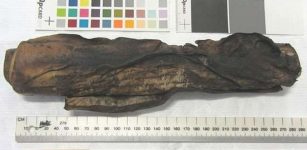 Hidden Text Discovered Inside Ancient Scroll
Archaeology | Oct 5, 2018
Hidden Text Discovered Inside Ancient Scroll
Archaeology | Oct 5, 2018 -
 The Great Pyramid And Ancient Egyptian Knowledge Shed Light On Biblical Mysteries – Surprising Information – Part 2
Ancient Mysteries | Nov 27, 2019
The Great Pyramid And Ancient Egyptian Knowledge Shed Light On Biblical Mysteries – Surprising Information – Part 2
Ancient Mysteries | Nov 27, 2019 -
 In Ancient California Matriarchal Society, Daughters Breastfed Longer And Women Accumulated Greater Wealth
Archaeology | Jul 13, 2023
In Ancient California Matriarchal Society, Daughters Breastfed Longer And Women Accumulated Greater Wealth
Archaeology | Jul 13, 2023 -
 Mysterious People Who Appeared Out Of Nowhere
Featured Stories | Sep 1, 2018
Mysterious People Who Appeared Out Of Nowhere
Featured Stories | Sep 1, 2018 -
 Old Bone Links Lost American Parrot To Ancient Indigenous Bird Trade
Archaeology | Nov 8, 2022
Old Bone Links Lost American Parrot To Ancient Indigenous Bird Trade
Archaeology | Nov 8, 2022 -
 The First ‘Viking’ Was A Bronze Age Man
Civilizations | Jul 26, 2024
The First ‘Viking’ Was A Bronze Age Man
Civilizations | Jul 26, 2024 -
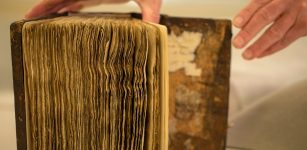 Hidden Text Of Medical Book By Doctor Galen Read For The First Time In 1000 Years
Archaeology | Mar 24, 2018
Hidden Text Of Medical Book By Doctor Galen Read For The First Time In 1000 Years
Archaeology | Mar 24, 2018 -
 DNA Study Reveals How Europe’s Hunter-Gatherers Adapted To A New Way Of Life – Farming
Archaeology | Nov 24, 2015
DNA Study Reveals How Europe’s Hunter-Gatherers Adapted To A New Way Of Life – Farming
Archaeology | Nov 24, 2015 -
 America’s Oldest City Caral Illegally Invaded And Archaeologist Threatened With Death
Archaeology | Jan 21, 2021
America’s Oldest City Caral Illegally Invaded And Archaeologist Threatened With Death
Archaeology | Jan 21, 2021 -
 Newport Ship: Experts Reassemble Medieval Vessel Found In The Mud
Featured Stories | Feb 7, 2023
Newport Ship: Experts Reassemble Medieval Vessel Found In The Mud
Featured Stories | Feb 7, 2023 -
 Vimana Temples – Architectural Marvel Of India
Civilizations | Dec 31, 2018
Vimana Temples – Architectural Marvel Of India
Civilizations | Dec 31, 2018 -
 Barabar Caves: The Oldest Surviving Rock-Cut Caves With Acoustic Effects In India
Featured Stories | Jul 1, 2021
Barabar Caves: The Oldest Surviving Rock-Cut Caves With Acoustic Effects In India
Featured Stories | Jul 1, 2021 -
 Controversial Theory Suggests Atlantis Was In Scandinavia – Surprising Evidence Presented By Ancient Writer
Ancient Mysteries | Sep 5, 2018
Controversial Theory Suggests Atlantis Was In Scandinavia – Surprising Evidence Presented By Ancient Writer
Ancient Mysteries | Sep 5, 2018

